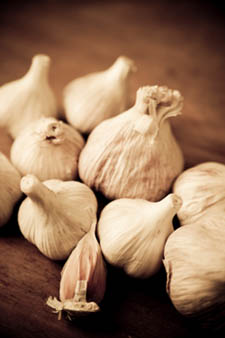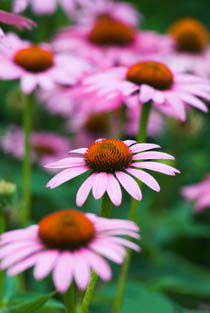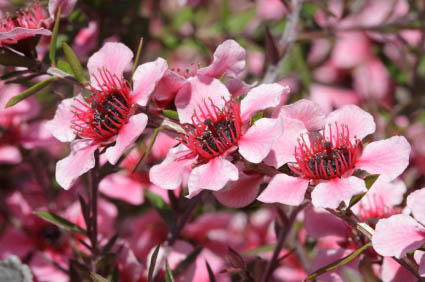by Linda B. White, M.D.Germs are everywhere. Some take up residence in our bodies and do us good, such as the friendly bacteria that colonize the linings of the intestines, upper respiratory tract, and lower urinary system, out-competing bad microbes, contributing to immune defense and good digestion. Other microbes – viruses, bacteria, parasites – wreak havoc when they invade our bodies. Fortunately, a number of herbs have antimicrobial effects. Many of these herbs are culinary herbs and spices, such as garlic, ginger, thyme, and cinnamon. That means, no matter where you are, you can probably find an herbal ally at the local grocery store. Herbs don’t act as quickly or as potently as drugs. For serious infections, antibiotics can save lives. On the other hand, herbs produce fewer side effects and don’t seem to be associated with the microbial resistance that plagues antibiotics. |
 Garlic (Allium sativum) has broad activity against a number of organisms and also promotes immune function. People around the globe have used the bulb as food and medicine for thousands of years. Four French thieves added to garlic’s fame by staying alive as they either robbed or interred (the story varies) victims of the plague. Their alleged secret? Internal and external use of a vinegar made of garlic and other antimicrobial herbs. This ‘vinaigre des quatre voleurs’ is still sold in France. Garlic has antibacterial activity againstStaphylococcus,Streptococcus, Proteus,Pseudomonas,Mycobacterium, as well as species associated with diarrhea (Escherichia coli, Salmonella, Clostridum, Klebsiella, Bacillus subtulis). Happily, though somewhat mysteriously, garlic interferes with disease-causing bacteria, rather than the “friendly” bacteria such as Lactobacillus that colonize the intestines. Garlic also tackles fungi (Candida, Cryptococcus, Trichophytoni) and parasites such as (Giardia lamblia, Entamoeba histolytica,Trypanosomes, Leishmania). Garlic (Allium sativum) has broad activity against a number of organisms and also promotes immune function. People around the globe have used the bulb as food and medicine for thousands of years. Four French thieves added to garlic’s fame by staying alive as they either robbed or interred (the story varies) victims of the plague. Their alleged secret? Internal and external use of a vinegar made of garlic and other antimicrobial herbs. This ‘vinaigre des quatre voleurs’ is still sold in France. Garlic has antibacterial activity againstStaphylococcus,Streptococcus, Proteus,Pseudomonas,Mycobacterium, as well as species associated with diarrhea (Escherichia coli, Salmonella, Clostridum, Klebsiella, Bacillus subtulis). Happily, though somewhat mysteriously, garlic interferes with disease-causing bacteria, rather than the “friendly” bacteria such as Lactobacillus that colonize the intestines. Garlic also tackles fungi (Candida, Cryptococcus, Trichophytoni) and parasites such as (Giardia lamblia, Entamoeba histolytica,Trypanosomes, Leishmania). |
Antiviral activity includes influenza A and B, cytomegalovirus, rhinovirus, HIV, herpes simplex virus 1 and 2, rotavirus, and some species that cause pneumonia. One study found that people who took a garlic supplement for 12 weeks from November through February had far fewer colds that those who took a dummy pill. Other Allium species (chives, onions, leeks) have antimicrobial activity too. Much of the information about garlic’s antimicrobial power comes from lab studies. Less is known about how well garlic preparations work in humans infected with these “bugs.” The same can be said about most of the other herbs listed below. Heat deactivates garlic’s antimicrobial ingredients. For that reason, it’s best to consume it raw or as a tablet that promises a certain amount of allicin (a key active chemical). If you apply garlic topically as a paste, protect the skin with olive oil (or some other oil), cover with gauze or clean cloth, and remove after an hour.
Ginger (Zingiber officinale) has scientific backing as an anti-nausea agent. It may offer other benefits to those stricken with infections diarrhea. Alcohol extracts of ginger are active against bacteria that infect the intestinal tract (Salmonella typhimurium, Escherichia coli, Vibrio cholerae Pseudomonas aeruginosa, Helicobacter pylori), skin and other soft tissues (Staphylococcus aureus), and respiratory tract (Streptococcus pyogenes, Streptococcus pneumoniae, Haemophilus influenzae). Ginger has antifungal activity against the yeast Candida albicans. It also discourages intestinal worms. Because studies have shown that heat deactivates the antibacterial effect, it may be best to consume ginger raw, or in tincture or capsule form. A number of other culinary spices not only enhance flavor, but also help preserve food due to their antimicrobial effects. For instance, the two main species of cinnamon, Cinnamomum cassia (also called C. aromaticum) and Cinnamomum verum (also called C. zeylanicum), both have antibacterial and antihelminthic (anti-worm) effects. Other culinary spices and herbs that fit into this category include clove, nutmeg, chili peppers (including cayenne), horse raddish, cumin, and tamarind. Several mint family plants commonly used as culinary and medicinal herbs counter infection. Members of this family owe their characteristic tastes, smells, and medicinal effects to their essential oils, some of which are antimicrobial. Examples includethyme (Thymus vulgarus and other species), sage (Salvia officinalis), oregano (Origanum vulgare and other species),rosemary (Rosmarinus officinalis), basil (Ocimum basilicum),lavender (Lavandula species), peppermint (Mentha X piperita), and spearmint (Mentha spicata). Thyme, bee balm (Monarda fistulosa and Monarda didyma), and oregano contain the potent antimicrobial chemical thymol, which is a key ingredient in Listerine®. There are many ways you can make use of mint-family herbs. For instance, if you’ve come down with a cold or flu-like illness, you can make broth-based vegetable soup, adding thyme, rosemary, and oregano before serving. If you have cough or nasal congestion, you can boil a pot of water, add a handful of mint-family herbs (which are also decongesting and expectorant), cover and steep for 10 to 15 minutes. Remove the lid, lean over, corral the vapors with a towel, and inhale deeply. Eucalyptus, though not in the mint family, is another great herb to use in steam inhalation. Alternatively, you can add one or two drops of essential oil of peppermint essential oil just-boiled water and inhale the vapors. Thyme and oregano are too irritating to use in steam inhalation. If you have asthma, inhalation of essential-oil-laced steam may provoke bronchospasm (tightening of the airways) and is therefore not recommended. Do not take essential oils internally. If you have a sore throat, you can gargle with a tea made from mint-family plants or their essential oils. Sage tea is often recommended for this purpose. If you wish to gargle with it, add ¼ teaspoon salt to ½ cup hot (but not scalding) tea. One study found a throat spray made with echinacea (which is antiseptic, immune enhancing,and numbing) and sage worked as well as a conventional spray made from the antiseptic chlorhexidine plus the anesthetic lidocaine. An earlier study showed that a spray made from sage alone was more effective than a dummy spray. If you use essential oil, add only 1 drop to a cup of salty water in a jar and shake well before gargling. Because plant essential oils are very strong, do not drink this mixture. Simply gargle and split.
 As mentioned in the previous paragraph,echinacea has some antiviral and antibacterial properties, though its ability to help people recover faster from infections seems to stem from immune enhancement. However, a recent study found that Echinaforce®, a special extract made from Echinacea purpurea, inhibited some respiratory bacteria, including Streptococcus pyogenes, the cause of “strep throat.” Studies have yet to evaluate the use of this product in treating “strep throat.” Because such infection can cause signification illness and complications such as rheumatic heart disease, antibiotics are recommended. That said, a number of studies have shown that good product, taken frequently in adequate amounts can shorten the course of viral respiratory infection. As mentioned in the previous paragraph,echinacea has some antiviral and antibacterial properties, though its ability to help people recover faster from infections seems to stem from immune enhancement. However, a recent study found that Echinaforce®, a special extract made from Echinacea purpurea, inhibited some respiratory bacteria, including Streptococcus pyogenes, the cause of “strep throat.” Studies have yet to evaluate the use of this product in treating “strep throat.” Because such infection can cause signification illness and complications such as rheumatic heart disease, antibiotics are recommended. That said, a number of studies have shown that good product, taken frequently in adequate amounts can shorten the course of viral respiratory infection. |
Black elderberry (Sambucas nigra) and licorice (Glycyrrhiza glabra) are two other herbs to keep handy during the cold and flu season. Elderberry has antiviral activity against influenza viruses and enhances immune function. A proprietary elderberry extract (Sambucol®) significantly shortens the severity and duration of influenza. Licorice root is demulcent (soothing), expectorant (expels respiratory mucus), antiviral, and immune enhancing. Because it acts on the kidneys to stimulate retention of sodium and water (and loss of potassium), it can’t be taken for more than a few days running. It should not be taken by pregnant women, nor people with heart disease, kidney disease, or high blood pressure.
Berberine is an antimicrobial plant chemical present in herbs such as goldenseal (Hydrastis Canadensis), Oregon grape (Berberis aquifolium), barberry (Berberis vulgaris), and coptis or goldenthread (Coptis chinensis). The bad news is that this chemical isn’t well absorbed from the intestinal tract. In other words, if you have a sinus infection, taking goldenseal or Oregon grape root by mouth likely won’t deliver much berberine to your sinuses. The good news is that berberine does a good job of treating intestinal infections. Studies show that it inhibits bacterial diarrhea caused by Vibrio cholera and Escherichia coli. Berberine is also antiparasitic against Giardia lamblia, Entamoeba histolytica(amoebas), Trichomonas vaginalis, and Leishmania donovani. Studies also show that berberine helps clear giardia in humans. It’s also reasonable to apply root preparations topically to infected areas. For instance, a well-strained decoction (with ¼ teaspoon salt added for each cup) could be used as a nasal douche for sinusitis, a vaginal douche, or an eyewash for mild pinkeye. Studies have demonstrated success in treating a serious eye infection caused by Chlamydia trachomatis. Nevertheless, you should see your doctor if the whites of one or both your eyes look inflamed, especially in the presence of a yellow-green discharge. Cranberry (Vaccinium macrocarpon), taken as a juice or concentrated in tablet form, interferes with bacterial adherence to bladder lining, thus preventing infection. Most of the research has been in women (elderly women, young sexually-active women, and pregnant women) prone to repeat bladder infections. Once infection begins, the bacteria have already attached to the bladder lining. At that point, antibiotics can clear the infection swiftly and prevent bacteria from ascending to the kidneys. For prevention, the juice dosage used in studies ranges from 4 to 32 ounces a day. Alternatively, concentrated juice extract can be taken at a dosage of one 300-400 milligram tablet, two to three times a day. Side effects can include gastrointestinal upset. Also, chemical constituents of cranberry may inhibit the enzymes that break down drugs, thereby raising blood levels of medications such as Coumadin, Valium, Elavil, Motrin, and others.
 Pink New Zealand Tea Tree |
Posted via email from WellCare



No comments:
Post a Comment